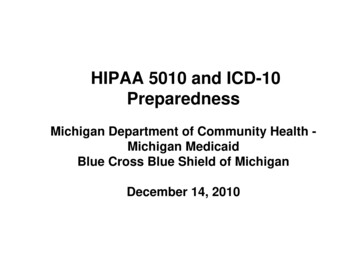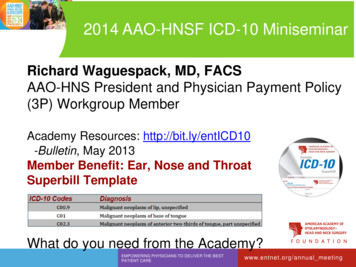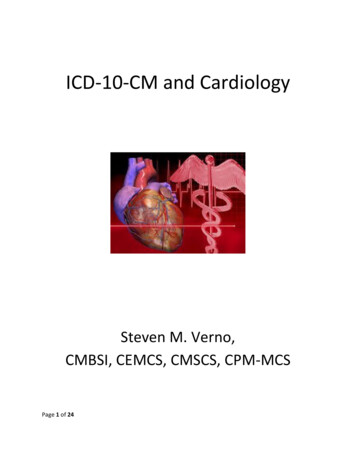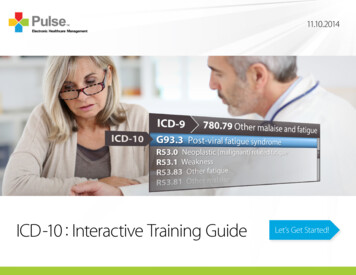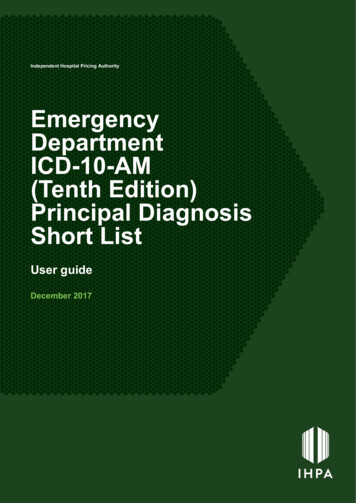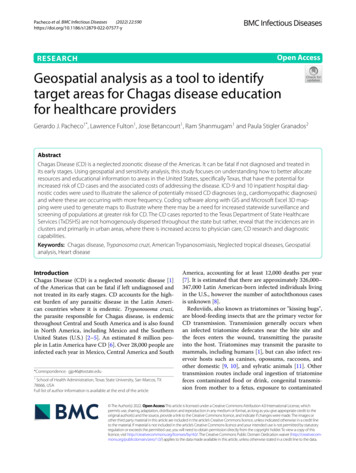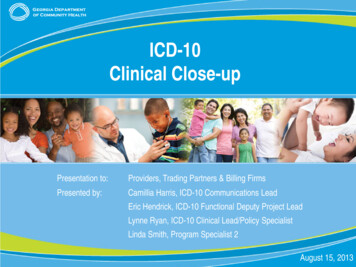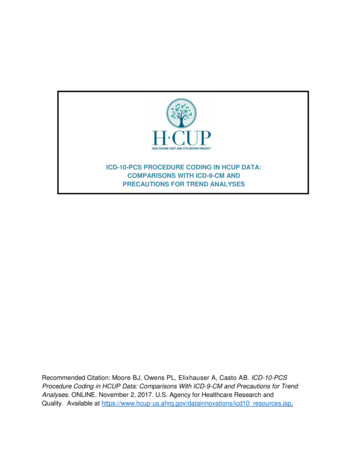
Transcription
ICD-10Clinical Conceptsfor OB/GYNICD-10 Clinical Concepts SeriesCommon CodesClinical Documentation TipsClinical ScenariosICD-10 Clinical Concepts for OB/GYN is a feature ofRoad to 10, a CMS online tool built with physician input.With Road to 10, you can:lBuild an ICD-10 action plan customized foryour practicel Useinteractive case studies to see howyour coding selections compare with yourpeers’ codingllAccess quick references from CMS andmedical and trade associationsView in-depth webcasts for and by medicalprofessionalsTo get on the Road to 10 and find out more about ICD-10, visit:cms.gov/ICD10roadto10.orgICD-10 Compliance Date: October 1, 2015Official CMS Industry Resources for the ICD-10 Transitionwww.cms.gov/ICD101
Table Of ContentsCommon Codes Abnormal Female GenitalCytology (ExcludingNeoplasia and MalignancyCodes) Selected Menopausal andother PerimenopausalDisorders Excessive, Frequent andIrregular Menstruation Noninflammatory Disordersof Ovary, Fallopian Tubesand Broad Ligament General Medical andGynecological Examinations Supervision of NormalPregnancy Hypertension Urinary Tract Infection,Cystitis Inflammation of Vagina andVulva Lump in Breast and OtherDisorders of BreastPrimer for Clinical Documentation Trimester Intent of Encounter Vomiting Complications of Pregnancy Abortion Alcohol Use, SubstanceAbuse and TobaccoDependence Childbirth and PuerperiumDistinct from TrimesterClinical Scenarios Scenario 1: Abdominal Pain& Ovarian Cyst Scenario 2: Breast Lump/Annual Well Woman Exam Scenario 3: Preeclampsia Scenario 4: BacterialVaginosis
Common CodesICD-10 Compliance Date: October 1, 2015Abnormal Female Genital Cytology (Excluding Neoplasia andMalignancy Codes) (ICD-9-CM 622.10, 622.11, 622.12, 792.9, 795.01to 795.19 range, 87.820R87.821Atypical squamous cells of undetermined significance on cytologic smearof cervix (ASC-US)Atypical squamous cells cannot exclude high grade squamous intraepithelial lesion on cytologic smear of cervix (ASC-H)Low grade squamous intraepithelial lesion on cytologic smear of cervix (LGSIL)High grade squamous intraepithelial lesion on cytologic smear of cervix (HGSIL)Unsatisfactory cytologic smear of cervixSatisfactory cervical smear but lacking transformation zoneOther abnormal cytological findings on specimens from cervix uteriUnspecified abnormal cytological findings in specimens from cervix uteriAtypical squamous cells of undetermined significance on cytologic smear of vagina (ASC-US)Atypical squamous cells cannot exclude high grade squamous intraepithelial lesion on cytologic smear of vagina (ASC-H)Low grade squamous intraepithelial lesion on cytologic smear of vagina (LGSIL)High grade squamous intraepithelial lesion on cytologic smear of vagina (HGSIL)Unsatisfactory cytologic smear of vaginaOther abnormal cytological findings on specimens from vaginaUnspecified abnormal cytological findings in specimens from vaginaAbnormal cytological findings in specimens from other female genital organsMild cervical dysplasiaModerate cervical dysplasiaDysplasia of cervix uteri, unspecifiedCervical high risk human papillomavirus (HPV) DNA test positiveVaginal high risk human papillomavirus (HPV) DNA test positiveCervical low risk human papillomavirus (HPV) DNA test positiveVaginal low risk human papillomavirus (HPV) DNA test positive*Codes with a greater degree of specificity should be considered first.3
Excessive, Frequent and Irregular Menstruation (ICD-9-CM 626.2To 626.6 Range, e and frequent menstruation with regular cycleExcessive and frequent menstruation with irregular cycleExcessive menstruation at pubertyOvulation bleedingExcessive bleeding in the premenopausal periodOther specified irregular menstruationIrregular menstruation, unspecified*Codes with a greater degree of specificity should be considered first.General Medical and Gynecological Examinations (ICD-9-CM V70.0,V72.31, V72.32) (Excluding Contraceptive and Procreative Codes)Z00.00 Encounter for general adult medical exam without abnormal findingsZ00.01 Encounter for general adult medical exam with abnormal findingsZ01.411 Encounter for gynecological examination (general) (routine) with abnormal findingsZ01.419 Encounter for gynecological examination (general) (routine) without abnormal findingsZ01.42 Encounter for cervical smear to confirm findings of recent normal smear following initial abnormal smear*Codes with a greater degree of specificity should be considered first.Hypertension (ICD-9-CM 401.9)I10Essential (primary) hypertension*Codes with a greater degree of specificity should be considered first.4
Inflammation of Vagina and Vulva (ICD-9-CM 616.10, 616.4, 616.50,616.81, 6.89Acute vaginitisSubacute and chronic vaginitisAcute vulvitisSubacute and chronic vulvitisAbscess of vulvaUlceration of vaginaUlceration of vulvaMucositis (ulcerative) of vagina and vulvaOther specified inflammation of vagina and vulva*Codes with a greater degree of specificity should be considered first.Lump in Breast and Other Disorders of the Breast (ICD-9-CM 611.2, 611.3,611.4, 611.5, 611.6, 611.71 to 611.79 range, 611.81 To 611.89 range, .53N64.59N64.81N64.82N64.89N64.9*Unspecified lump in breastFissure and fistula of nippleFat necrosis of breastAtrophy of breastGalactorrhea not associated with childbirthMastodyniaInduration of breastNipple dischargeRetraction of nippleOther signs and symptoms in breastPtosis of breastHypoplasia of breastOther specified disorders of breastDisorder of breast, unspecified*Codes with a greater degree of specificity should be considered first.5
Selected Menopausal and Other Perimenopausal Disorders (ICD-9CM 627.0 to 627.9 range) (Excluding Post-menopausal Osteoporosis and Urethritis Codes)N92.4N95.0N95.1N95.2N95.8N95.9*Excessive bleeding in the premenopausal periodPostmenopausal bleedingMenopausal and female climacteric statesPostmenopausal atrophic vaginitisOther specified menopausal and perimenopausal disordersUnspecified menopausal and perimenopausal disorder*Codes with a greater degree of specificity should be considered first.Noninflammatory Disorders of Ovary, Fallopian Tubes, and Broadligament (ICD-9-CM 620.0 to 620.9 r cyst of ovaryCorpus luteum cystUnspecified ovarian cystsOther ovarian cystsAcquired atrophy of ovaryAcquired atrophy of fallopian tubeAcquired atrophy of ovary and fallopian tubeProlapse and hernia of ovary and fallopian tubeTorsion of ovary and ovarian pedicleTorsion of fallopian tubeTorsion of ovary, ovarian pedicle and fallopian tubeHematosalpinxHematoma of broad ligamentOther noninflammatory disorders of ovary, fallopian tube & broad ligamentNoninflammatory disorder of ovary, fallopian tube and broad ligament,unspecified*Codes with a greater degree of specificity should be considered first.6
Supervision of Normal Pregnancy (ICD-9-CM V22.0, V22.1, Z34.83Z34.90*Z34.91*Z34.92*Z34.93*Encounter for supervision of normal first pregnancy, unspecified trimesterEncounter for supervision of normal first pregnancy, first trimesterEncounter for supervision of normal first pregnancy, second trimesterEncounter for supervision of normal first pregnancy, third trimesterEncounter for supervision of other normal pregnancy, unspecified trimesterEncounter for supervision of other normal pregnancy, first trimesterEncounter for supervision of other normal pregnancy, second trimesterEncounter for supervision of other normal pregnancy, third trimesterEncounter for supervision of normal pregnancy, unspecified, unspecified trimesterEncounter for supervision of normal pregnancy, unspecified, first trimesterEncounter for supervision of normal pregnancy, unspecified, second trimesterEncounter for supervision of normal pregnancy, unspecified, third trimester*Codes with a greater degree of specificity should be considered first.Urinary Tract Infection, Cystitis (ICD-9-CM 599.0, 595.0, 595.1,595.2, 595.3, 595.4, 595.5, 595.81, 595.82, te cystitis without hematuriaAcute cystitis with hematuriaInterstitial cystitis (chronic) without hematuriaInterstitial cystitis (chronic) with hematuriaOther chronic cystitis without hematuriaOther chronic cystitis with hematuriaTrigonitis without hematuriaTrigonitis with hematuriaIrradiation cystitis without hematuriaIrradiation cystitis with hematuriaOther cystitis without hematuriaOther cystitis with hematuriaCystitis, unspecified without hematuriaCystitis, unspecified with hematuriaUrinary tract infection, site not specified*Codes with a greater degree of specificity should be considered first.7
Clinical Documentation TipsICD-10 Compliance Date: October 1, 2015Specifying anatomical location and laterality required by ICD-10 is easier than you think. This detail reflects howphysicians and clinicians communicate and to what they pay attention - it is a matter of ensuring the information iscaptured in your documentation.In ICD-10-CM, there are three main categories of changes: Definition Changes Definition Change Increased SpecificityOver 1/3 of the expansion of ICD-10 codes is due to the addition of laterality (left, right, bilateral). Physicians and otherclinicians likely already note the side when evaluating the clinically pertinent anatomical site(s).TRIMESTERDefinition ChangeDocumentation of trimester is required. Determination is calculated from first day of last menstrual period, and isdocumented in weeks.The definitions of trimesters are:1. First TrimesterLess than 14 weeks, 0 days2. Second Trimester14 weeks, 0 days through 27 weeks and 6 days3. Third Trimester28 weeks through deliveryICD-10 Code ExamplesO26.851Spotting complicating pregnancy, first trimesterO26.852Spotting complicating pregnancy, second trimesterO26.853Spotting complicating pregnancy, third trimesterO26.859Spotting complicating pregnancy, unspecified trimester8
VOMITINGDefinition ChangeThe time frame for differentiating early and late vomiting in pregnancy has been changed from 22 to 20 weeks.ICD-10 Code ExamplesO21.0Mild hyperemesis gravidumO21.2Late vomiting of pregnancyABORTIONDefiniton ChangeThe timeframe for a missed abortion (vs. fetal death) has changed from 22 to 20 weeks. In ICD-10-CM, an electiveabortion is now described as an elective termination of pregnancy.There are four spontaneous abortion definitions in ICD-10; use the appropriate definition in your documentation:1.Missed AbortionNo bleeding, os closed2. Threatened AbortionBleeding, os closed3. Incomplete AbortionBleeding, os open, products of conception (POC) are extruding4. Complete AbortionPossible bleeding or spotting, os closed, all POC expelledICD-10 Code ExamplesO02.1Missed abortionO36.4XX1Maternal care for intrauterine death, fetus 1Z33.2Encounter for elective termination of pregnancy9
CHILDBIRTH AND PUERPERIUM DISTINCT FROM TRIMESTERTerminology DifferenceICD-10 allows for the description of “pregnancy”, “childbirth” and “puerperium” as distinct conceptsfrom “trimester.”ICD-10 Code ExamplesO99.351O99.352Diseases of the nervous system complicating pregnancy, first trimesterDiseases of the nervous system complicating the pregnancy, second trimesterINTENT OF ENCOUNTERIncreased SpecificityWhen documenting intent of encounter, include the following:1.Type of Encountere.g. OB or GYN, contraception management, postpartum care2. ComplicationsNote any abnormal findings with examinationICD-10 Code ExamplesZ30.011Encounter for initial prescription of contraceptive pillsZ39.1Encounter for care and examination of lactating motherZ31.82Encounter for Rh incompatibility status10
COMPLICATIONS OF PREGNANCYIncreased SpecificityDocumentation of conditions/complications of pregnancy will need to distinguish between pre-existing conditions,or pregnancy-related conditions.When documenting well child exams and screen, include the following:1. Condition DetailWas the condition pre-existing (i.e. present before pregnancy)2. TrimesterWhen did the pregnancy-related condition develop?3. Casual RelationshipEstablish the relationship between the pregnancy and the complication (i.e.preeclampsia)ICD-10 Code ExamplesO99.011O13.2O24.012Anemia complicating pregnancy, first trimesterGestational [pregnancy-induced] hypertension without significantproteinuria, second trimesterPre-existing diabetes mellitus, type 1, in pregnancy, second trimesterALCOHOL USE, SUSTANCE ABUSE, AND TOBACCO DEPENDENCEIncreased SpecificityDocumentation should capture the mother’s use (or non-use) of tobacco, alcohol and substance abuse along withthe associated risk to the child.A secondary code from category F17, nicotine dependence or Z72.0, tobacco use should also be assigned whencodes associated with category O99.33, smoking (tobacco) complicating pregnancy are used. In a similar manner, asecondary code from category F10, alcohol related disorders, should also be assigned when codes under categoryO99.31, Alcohol use complicating pregnancy, are used.ICD-10 Code ExamplesO99.311O99.331O35.4XX1Alcohol use complicating pregnancy, first trimesterSmoking (tobacco) complicating pregnancy, first trimesterMaternal care for (suspected) damage to fetus from alcohol, fetus111
OB/GYN Practice Clinical ScenariosICD-10 Compliance Date: October 1, 2015Quality clinical documentation is essential for communicating the intent of an encounter, confirming medical necessity,and providing detail to support ICD-10 code selection. In support of this objective, we have provided outpatient focusedscenarios to illustrate specific ICD-10 documentation and coding nuances related to your specialty.The following scenarios were natively coded in ICD-10-CM and ICD-9-CM. As patient history and circumstances willvary, these brief scenarios are illustrative in nature and should not be strictly interpreted or used as documentation andcoding guidelines. Each scenario is selectively coded to highlight specific topics; therefore, only a subset of the relevantcodes are presented.Scenario 1: Abdominal Pain & Ovarian CystScenario DetailsChief Complaint Abdominal pain that will not go away and irregular menses.HistoryExam 21 year old female G2P1001 with RLQ abdominal pain1 for the last 6 months. Pain is a dull ache. Reports 2 periods in the last year. Historically cycles have been regular lasting 28 – 30 dayseach. LMP was 4 months ago. No family history of ovarian or cervical cancer. Patient had a benign ovarian cyst successfully removed at age 172. Abdomen is soft. RLQ is tender to palpation. No rebound tenderness3 or guarding of abdomen.Bowel sounds normal in all 4 quadrants. Pelvic shows cervical motion tenderness and adnexal tenderness on the right. Mild right ovarian tenderness. No palpable ovarian or uterine enlargement. Urine pregnancy test is negative.12
Scenario 1: Abdominal Pain & Ovarian Cyst (continued)Assessment and Plan Given patient history and clinical findings right ovarian cyst is suspected. Order transvaginal ultrasound to rule out ovarian cyst. Patient counseled on pain relief exercises. Pain Rx also given. Scheduled a follow-up visit in 1 week.Summary of ICD-10-CM ImpactsClinical Documentation1. There are separate ICD-10-CM codes for each quadrant of the abdomen when describing pain.This information needs to be captured in the note. Providing a detailed description of the pain characteristics is important as well. The documentation and context of the pain presentation will determine if additional codes are assigned, that is, if the pain is considered part of the disease process, an additionalcode for pain will not be listed. To address this point in the coding section we have presented bothcombinations (N94.89 Other specified conditions associated with female genital organs and menstrualcycle OR N92.5 Other specified irregular menstruation AND R10.31 Pain localized to other parts oflower abdomen, right lower quadrant pain).2. It is important to include the patient history, as this can justify additional diagnostic testing.3. In ICD-10-CM abdominal tenderness is differentiated to address the rebound characteristic withdifferent codes.ICD-9-CM Diagnosis Codes629.89 OROther specified disordersof female genital organs626.4Irregular menstrual cycle789.03Abdominal pain, right lowerquadrant789.63Abdominal tenderness, rightlower quadrantV13.29Personal history of othergenital system and obstetricdisordersICD-10-CM Diagnosis CodesN94.89 OROther specified conditionsassociated with femalegenital organs and menstrualcycleN92.5Other irregular menstruationR10.31Pain localized to other partsof lower abdomen, rightlower quadrant painR10.813Right lower quadrantabdominal tendernessZ87.42Personal history of otherdiseases of the femalegenital tractOther Impacts Identifying the specific area of abdominal pain is important, as some payers may deny claimswith “unspecified” codes. Providing the patient history can justify additional diagnostic tests (such as the ultrasound here).13
Scenario 2: Breast Lump/Annual Well Woman ExamScenario DetailsChief Complaint “I’ve found a lump on my left breast and I need my annual GYN exam1.”HistoryExam 47 year old perimenopausal female. G3P3003. LMP December 20, 2013. Last Pap was normal. No history of STD. No family history of ovarian or cervical cancer. No significant changesover the last year. Positive family history for breast cancer – mother and all three sisters. Sisters are BRCA. Reports finding a small lump in left breast4. Pelvic exam is normal. Pap smear performed.2 Left breast examined normal except for 1.5cm mass on left lower/outer quadrant5. Mass istender, easily moveable, firm to touch. Axilla normal, without palpable nodes. Right breast normal.Assessment and Plan Normal pelvic exam. Will confirm Pap results with the patient. Scheduled fine needle aspiration of left breast mass at the end of this week – with Dr. Smith. Scheduled a follow-up visit in 1 week to discuss aspiration results and next steps.Summary of ICD-10-CM ImpactsClinical Documentation1. Note whether the encounter is for a specific issue or an annual or “general” exam. There are different diagnosiscodes for each. The use of the best code may vary by payor according to what services were rendered and theinsurance plan’s reimbursement of a well women annual visit versus reimbursement of pelvic and/or clinicalbreast examinations. As per American Congress of Obstetricians and Gynecologists’ guidelines, a well womenexam includes both a pelvic exam as well as a clinical breast examination. The rationale for abnormal findings inthis encounter is based on the presence of the breast lump.2. Using ICD-9 codes, Pap smear coding may vary by payor. In some cases payors reimburse for the retrieval ofthe Pap smear by the physician, and the screening Pap smear at a specific frequency (e.g., every 2 years). Withthe new terminology associated with ICD-10-CM codes this point will need to be assessed and confirmed socorrect code assignment can occur.3. Like ICD-9, family history can be captured in ICD-10-CM. Capture that information as appropriate in your note.As there is a positive family history for breast cancer denoted with the three sisters identified as BRCA positive,the documentation supports the patient’s susceptibility to a malignancy of the breast.4. ICD-10-CM can now capture the side of the body. There are separate codes for left and right breast diagnoses. As the clinical status for this patient is not known, it does not have right versus left, e.g. solitary cyst of leftbreast.5. It is important to describe the mass in as much detail as possible. Even though it is not possible to definitivelydiagnose the mass at this visit, the provider can code for symptoms and justify referral & subsequent treatment.14
Scenario 2: Breast Lump/Annual Well Woman Exam (continued)CodingICD-9-CM Diagnosis CodesICD-10-CM Diagnosis Codes611.72 Lump or mass in breastN63Unspecified lump in breast, which includes:nodule(s) NOS in breastZ01.411 Encounter for gynecological examination(general) (routine) with abnormal findingsV72.31 Routine gynecologic exam, with orwithout pap testV76.2 Routine screening pap test, intactcervixV84.01 Genetic susceptibility, malignantneoplasm breastZ15.01 Genetic susceptibility to malignant neoplasmof breastOther Impacts Providing the patient history can justify additional diagnostic tests based on the patient’s risk (such asthe fine needle aspiration). Capturing the appropriate side of the body is important, as some payers may deny claims without thisinformation.15
Scenario 3: PreeclampsiaScenario DetailsChief Complaint Headache, nausea and vomiting x 2 over last 48 hours.History 32 year nulliparous female well known to me presents today at 36 2/72 weeks gestational agefor a scheduled prenatal visit. Long time history migraine headaches. In this pregnancy her BPsare ranging from 125/85 to 135/90 at previous prenatal visits. Over the past 2 days she has notbeen able to perform usual activities due to her symptoms. Reports continued fetal movement, no contractions, and no vaginal bleeding. Having her typicalmigraine now. Denies dizziness, LOC, tremors, seizures, epigastric or abdominal pain, muscleweakness/pain, malaise, drowsiness, pelvic cramping, dysuria, hematuria. Medical history and review of systems – migraines with many triggers including hormonalchanges, stress, and specific foods, otherwise no changes since last prenatal visit. LMP: August 2013. Diet and exercise: Vegan. On iron supplementation. Moderate activity 3-5 days per week. Allergies: sulfa drugs, penicillin (anaphylaxis noted). Denies tobacco, alcohol, or drug use. Pertinent Labs: U/A 2 proteinuria 2 glucose. Family history: Mother and father living. Five siblings, four living. Family history positive for hypertension, migraines.Exam Vital Signs: BP 150/90, T 99.6 F, P 100, R 30. Wt: 157 lb., up 2 lb. from 2 weeks ago. Well nourished, well-groomed, A&Ox3, mood and affect calm. HEENT & Neck: Normal to exam. Respiratory: Lungs clear to auscultation. Chest examination unremarkable. Cardiac: S1/S2, no S3/S4, no murmurs. Rhythm is regular. Abdomen: Fundal height consistent with 36 weeks, single fetus, vertex and engaged; fetalweight 3,000g, FHR 142 bpm. Musculoskeletal: Adequate muscle tone full AROM x4. Deep tendon reflexes were 4 /4 withsustained knee and ankle clonus. Extremities: Generalized edema present, 2 bilateral edema LE. No cyanosis. Vaginal exam: Cervix fingertip dilated and 75% effaced. The vertex was presenting at 0 station.Membranes intact.Assessment and Plan Preeclampsia. Direct admit patient to Labor and Delivery unit to monitor for worsening preeclampsia orpreeclampsia complications. Admission orders: called and faxed to L&D unit nurse. Explained treatment plan and purpose for admission to patient and husband. EMS unitrequested and will transport to hospital.16
Scenario 3: Preeclampsia (continued)Summary of ICD-10-CM ImpactsClinical Documentation1. Similarly to ICD-9, ICD-10 describes preeclampsia as a complication of pregnancy which ischaracterized by hypertension; proteinuria and edema may also be present. ICD-10 differentiates fromICD-9 in clinical terminology to describe preeclampsia as mild to moderate, severe, or unspecified.Eclampsia is when seizures are associated with the preeclampsia condition. The HELLP syndrome ischaracterized as severe preeclampsia with hemolysis, elevated liver enzymes, and low platelet count.2. ICD-10 increases the alternatives for hypertensive disorders in pregnancy (with or without the presenceof proteinuria and/or edema); refer to an official ICD-10 guide for example alternatives.3. ICD-10 provides distinct coding options for the life-threatening HELLP syndrome to be coded as both avariant or complication of preeclampsia or eclampsia. Coding options also are sensitive to timing of theseconditions, reflecting that preeclampsia, eclampsia, and HELLP usually occur during the second or thirdtrimesters of pregnancy, or sometimes after childbirth.4. The American College of Obstetricians and Gynecologists (ACOG) published a practice guideline forpregnancy induced hypertension in 2013 which includes a revision of the criteria for preeclampsia. In thisscenario, we applied the ACOG guideline and are not coding the patient’s symptoms as they are consideredintegral to the disease process and her underlying medical condition. Also note that per ACOG guidelines,preeclampsia is no longer identified as mild, moderate, or severe, rather it is preeclampsia or preeclampsiawith severe features. The new ACOG guidelines are not currently reflected in ICD-10 and therefore theprevious criteria of mild, moderate and severe remains. ICD-10 codes to support ACOG guidelines will notbe changed within the code set until after national implementation. In the absence of severe features, theoptions for codes are mild to moderate or unspecified. The ACOG guidelines document can be accessedat: www.acog.org/Resources And Publications/Task Force and Work Group Reports/Hypertension in PregnancyCodingICD-9-CM Diagnosis CodesICD-10-CM Diagnosis Codes642.43 Mild or unspecified preeclampsia,antepartum conditionor complicationO14.Ø3Mild to moderate preeclampsia,third trimester648.93 Pregnancy complicated byconditions classified elsewhere,antepartum346.90 Migraine, w/o mention ofintractable or status migrainosusO99.89Pregnancy, complicated by disorder ofspecified body systemG43.9Ø9 Migraine, unspecified, not intractable w/ostatus migrainosusZ3A.3636 weeks gestationOther ImpactsNo specific impact noted.17
Scenario 4: Bacterial VaginosisScenario DetailsChief Complaint Vaginal discharge with odor x 1 week.History 28 year female, established patient, presents complaining of a thin, grayish-white vaginaldischarge with a noticeable fishy smell accompanied by vulvar itching. She first noticedsymptoms about 1 ½ weeks ago. Patient states she tried to self-treat using an over-the-counteryeast preparation approximately 1 week ago without relief of symptoms. She denies any historyof similar symptoms in the past. LMP: occurred 2 weeks ago, normal cycle for her. Last PAP exam 8 months ago, normal. Noprevious mammograms. Social history: Physically active. She is in a new monogamous relationship with male partner x 5weeks, sexually active with protection. Denies history of STIs. Admits to frequent douching andbubble baths. Immunizations: not immunized for HPV. No tobacco, alcohol, or other drug use. Review of systems negative except as noted above.Exam Vital Signs: BP 128/64, T 98.7 F, Ht. 63 in. Wt. 108 lbs. Well-groomed, A&Ox3. Pelvic: External exam-vulvar redness, no vulvar edema and no adherent white clumps present;Speculum exam – vaginal walls pink, cervix intact, closed os, thin gray and foul smellingdischarge noted in vaginal canal. Swab specimen obtained for microscopy exam. Bimanualexam – no pelvic tenderness, uterus smooth, uterus and adnexa are normal in size, ovaries notpalpable. Labs in office: Urine hCG – Negative; wet prep – Positive whiff test, clue cells and leukocytespresent; negative for yeast; vaginal pH elevated.Assessment & Plan Bacterial vaginosis.Prescribed 7-day metronidazole.Discussed and administered HPV vaccine in office today.Provided vaginal hygiene pamphlet. Instructed patient to avoid douching anduse of bubble bath products. Refrain from intercourse for one week after startingmetronidazole. Other activities as normal.18
Scenario 4: Bacterial Vaginosis (continued)Summary of ICD-10-CM ImpactsClinical Documentation1. Vaginitis is one of the most common gynecologic conditions encountered in the physician office setting.2. ICD-10-CM provides four alternative choices that map to the ICD-9 code 616.10 Vaginitis and vulvovaginitis, unspecified. The four options are N76.0 Acute vaginitis; N76.1 Subacute and chronic vaginitis; N76.2Acute vulvitis; and N76.3 Subacute and chronic vulvitis. As there is no indication of previous episodesand/or ongoing care, acute vaginitis is selected.3. Bacterial vaginosis is not usually associated with soreness, itching or irritation, therefore it is coded separately.4. In the scenario above for this patient with bacterial vaginosis, refraining from intercourse was recommended by this physician. To clarify, bacterial vaginosis is not considered an STI and physician recommendations for abstaining from sexual activity varies from physician to physician.5. This note intentionally does not include a discussion of STIs or reproductive planning which would becommonly denoted in the evaluation and counseling of a female of this age.6. ICD-9-CM includes a variety of vaccination codes while ICD-10-CM offers only one generic immunization code.CodingICD-9-CM Diagnosis Codes616.10698.1V04.89Vaginitis and vulvovaginitis,unspecifiedPruritis, vulvarNeed for prophylacticvaccination and inoculationagainst other viral diseasesICD-10-CM Diagnosis CodesN76.ØAcute vaginitisL29.2Z23Vulvar, pruritisEncounter for immunizationOther ImpactsIndex to Diseases for ICD-9-CM underthe word itching states “see also Pruritis”.Under Pruritis, vulvar that codes to 698.1ICD-9-CM has a variety of vaccination codesIndex to Diseases for ICD-10-CM under the worditching states “see also Pruritis”. Under Pruritis,vulvar that codes to L29.2ICD-10-CM Has only one generic immunizationcode19
ICD-10 Clinical Concepts Series. ICD-10 Clinical Concepts for OB/GYN is a feature of . Road to 10, a CMS online tool built with physician input. ICD-10 With Road to 10, you can: l Build an ICD-10 action plan customized for your practice l lUse interactive case studies to see how your coding selections compare with your peers' coding
